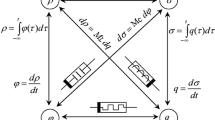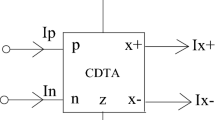Abstract
In this paper, new meminductor emulators have been proposed using operational transconductance amplifiers (OTA), a current differencing buffered amplifier (CDBA) and two grounded capacitors. Most meminductor emulators reported in the literature use memristor and resistor in their design but proposed emulators are memristor-less and resistor-less. The proposed emulators are designed for both decremental/incremental configurations of grounded and floating types of meminductors. The operating frequencies of the proposed emulators are extended up to 2 MHz for both grounded and floating configurations. The proposed circuits are electronically tunable as induced flux is controlled by changing the value of transconductance gain. The Monte-Carlo analysis and temperature analysis have been done and are found to be satisfactory. Simulation results have been obtained using Mentor Graphics Eldo simulation tool with 180 nm CMOS technology parameters. The performance of the proposed meminductor emulator has been verified by embedding the emulator in the design of adaptive learning circuits.























Similar content being viewed by others
References
Chua L O 1971 Memristor-the missing circuit element. IEEE Transactions on Circuit Theory 18: 507–519
Chua L O and Kang S M 1976 Memristive devices and systems. Proceedings of the IEEE 64: 209–223
Strukov D B, Snider G S, Stewart D R and Williams R S 2008 The missing memristor found. Nature 453: 80–83
Ventra M D, Pershin Y V and Chua L O 2009 Circuit elements with memory: Memristors, memcapacitors, and meminductor. Proceedings of the IEEE 97: 1717–1724
Ventra M D, Pershin Y V and Chua L O 2009 Putting memory into circuit elements: memristors, memcapacitors, and meminductors. Proceedings of the IEEE 97: 1371–1372
Pershin Y V and Ventra M D 2009 Memristive circuits simulate memcapacitors and meminductors. Electronics Letters 46: 517–518
Pershin Y V and Ventra M D 2011 Emulation of floating memcapacitors and meminductors using current conveyors. Electronics Letters 47: 243–244
MHz 2000 V/μs Monolithic op-amp AD844 1990 Analog Devices, Inc. Norwood, MA 02062-9106, USA
Yu D S, Liang Y, Lu H H C and Hu Y H 2014 Mutator for transferring a memristor emulator into meminductive and memcapacitive circuits. Chinese Physics B 23(070702): 1–11
Liang Y, Chen H and Yu D S 2014 A practical implementation of a floating memristor-less meminductor emulator. IEEE Transactions on Circuits and Systems II: Express Briefs 61: 299–303
Sah M P, Budhathoki R K, Yang C and Kim H 2014 Charge controlled meminductor emulator. Journal of Semiconductor Technology and Science 14: 750–754
Sah M P, Budhathoki R K, Yang C and Kim H 2014 A mutator-based meminductor emulator circuit. In: 2014 IEEE International Symposium on Circuits and Systems (ISCAS), pp. 2249–2252
Yu D S, Chen H and Lu H H C 2013 A meminductive circuit based on floating memristive emulator. In: 2013 IEEE International Symposium on Circuits and Systems (ISCAS), pp. 1692–1695
Wang H, Wang X, Li C and Chen L 2013 SPICE mutator model for transforming memristor into meminductor. In: Abstract and Applied Analysis Hindawi, pp. 1–5
Yu D, Liang Y, Lu H H and Chua L O 2014 A universal mutator for transformations among memristor, memcapacitor, and meminductor. IEEE Transactions on Circuits and Systems II: Express Briefs 61: 758–762
Fouda M E and Radwan A G 2014 Memristor-less current-and voltage-controlled meminductor emulators. In: 2014 21st IEEE International Conference on Electronics, Circuits and Systems (ICECS), pp. 279–282
Fouda M E and Radwan A G 2014 Simple floating voltage-controlled memductor emulator for analog applications. Radioengineering 23: 944–948
Wang S F 2016 The gyrator for transforming nano memristor into meminductor. Circuit World 42: 197–200
Yu D, Zhao X, Sun T, Lu H H and Fernando T 2019 A simple floating mutator for emulating memristor, memcapacitor, and meminductor. IEEE Transactions on Circuits and Systems II: Express Briefs 67: 1334–1338
A low cost four quadrant analog multiplier AD633 Analog Devices, Inc. Norwood, MA 02062-9106, USA
Zhao Q, Wang C and Zhang X 2019 A universal emulator for memristor, memcapacitor, and meminductor and its chaotic circuit. Chaos: An Interdisciplinary Journal of Nonlinear Science, 29: 013141 1-14
Yuan F and Li Y 2019 A chaotic circuit constructed by a memristor, a memcapacitor and a meminductor. Chaos: An Interdisciplinary Journal of Nonlinear Science, 29: 101101 1-15
Vista J and Ranjan A 2019 A High frequency meminductor emulator employing VDTA and its application. IEEE Transactions on Computer-Aided Design of Integrated Circuits and Systems 39: 2020–2028
Khalil N A, Said L A, Radwan A G and Soliman A M 2019 Emulation circuits of fractional-order memelements with multiple pinched points and their applications. Chaos, Solitons & Fractals 138: 109882
Taşkıran Z G C, Sağbaş M, Ayten U E and Sedef H 2020 A new universal mutator circuit for memcapacitor and meminductor elements. AEU-International Journal of Electronics and Communications 119(153180): 1–11
Yuan F, Jin Y and Li Y 2020 Self-reproducing chaos and bursting oscillation analysis in a meminductor-based conservative system. Chaos: An Interdisciplinary Journal of Nonlinear Science, 30: 053127 1-15
Sozen H and Cam U 2020 A novel floating/grounded meminductor emulator. Journal of Circuits, Systems and Computers 29(2050247): 1–25
Singh A and Rai S K 2020 Novel meminductor emulators using operational amplifiers and their applications in chaotic oscillators. Journal of Circuits, Systems, and Computers 30(2150219): 1–25
Yadav N, Rai S K and Pandey R 2021 New grounded and floating memristor-less meminductor emulators using VDTA and CDBA. Journal of Circuits, Systems and Computers 30(2150283): 1–31
Singh A and Rai S K 2021 VDCC-based memcapacitor/meminductor emulator and its application in adaptive learning circuit. Iranian Journal of Science and Technology, Transactions of Electrical Engineering,. https://doi.org/10.1007/s40998-021-00440-x
Biolek D, Biolek Z and Biolkova V 2009 SPICE modeling of memristive, memcapacitative and meminductive systems. In: Proc. 2009 European Conf. Circuit Theory and Design, pp. 249–252
Barranco B L, Vazquez A R, Sinencio E S and Huertas J L 1991 CMOS OTA-C high-frequency sinusoidal oscillators. IEEE Journal of Solid-State Circuits 26: 160–165
Acar Cevdet and Ozoguz Serdar 1999 A new versatile building block: current differencing buffered amplifier suitable for analog signal-processing filters. Microelectronics Journal 30: 157–160
Binkley D M 2008 Tradeoffs and optimization in Analog CMOS Design. Wiley, New York, pp 377–476
Pershin Y V, La F S and Di V M 2009 Memristive model of amoeba learning. Physical Review E 80: 021926
Pershin Y V and Di Ventra M 2010 Experimental demonstration of associative memory with memristive neural networks. Neural Networks 23: 881–886
Babacan Y and Kacar F 2017 FCS based memristor emulator with associative learning circuit application. Istanbul University-Journal of Electrical & Electronics Engineering 17: 3433–3437
Wang F Z, Chua L O, Yang X, Helian N, Tetzlaff R, Schmidt T, Li C, Carrasco J M G, Chen W and Chu D 2013 Adaptive neuromorphic architecture (ANA). Neural Networks 45: 111–116
Acknowledgement
This research work was financially supported by the University Grant Commision (UGC), New Delhi, India; by providing NFOBC fellowship (Student ID; 201819-NFO-2018-19-OBC-HAR-69999).
Author information
Authors and Affiliations
Corresponding author
Rights and permissions
About this article
Cite this article
Yadav, N., Rai, S.K. & Pandey, R. New high frequency memristorless and resistorless meminductor emulators using OTA and CDBA. Sādhanā 47, 8 (2022). https://doi.org/10.1007/s12046-021-01785-z
Received:
Revised:
Accepted:
Published:
DOI: https://doi.org/10.1007/s12046-021-01785-z




